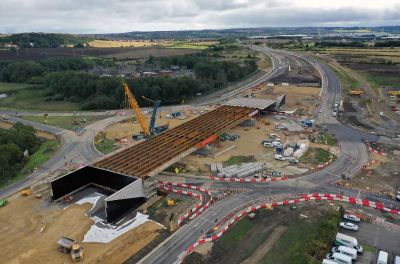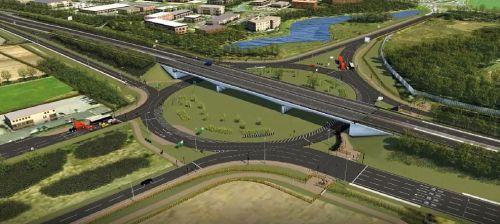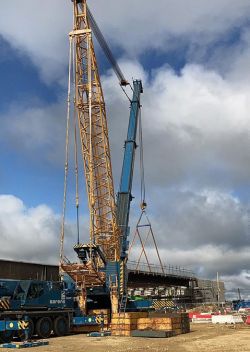A19 Testo’s Junction Improvement Scheme, Tyne and Wear
Article in NSC January 2021
Up the junction
Weathering steel has proven to be the ideal choice for a new 142m-long bridge forming an integral part of Highways England’s A19 Testo’s Junction Improvement Scheme.
A multi-million-pound scheme, which aims to ease congestion and cut journey times at one of the busiest junctions in the North East has reached a significant milestone with the completion of the steel erection for its all-important flyover bridge. Testo’s roundabout is a major junction connecting the A19 with the A184 in South Tyneside. The work being undertaken will raise the A19 onto a flyover and build new slip roads to connect it to the A184 via the roundabout below, thereby allowing through-traffic on the busy trunk route to flow freely. New routes will also be provided through the junction for pedestrians, cyclists and horse riders.
The A19 Testo’s upgrade is a significant part of the government’s five-year £15bn plan to improve the national road network. The improvements to the junction are being conducted with an investment of some £124.5M. Currently, Testo’s Junction suffers severe congestion at peak times, with delays of up to four minutes per vehicle. Traffic flows through the junction are expected to reach 83,400 vehicles every day by 2033. The scheme aims to improve journey times (savings of around four minutes by 2036) and increase capacity.
The centrepiece flyover bridge is a 142m-long weathering steel structure, fabricated, supplied and erected by locally-based Cleveland Bridge. Weathering steel was chosen as it does not require any future maintenance or repainting. This is an important consideration for a bridge sat in the middle of a busy roundabout, where any maintenance work could cause significant traffic disruption.
In contrast to other steels, which usually look their best immediately after being erected, weathering steel is said to improve after a couple of years exposure to the elements. This is why architects increasingly specify it for use on buildings in a design where it is fully exposed. “The colour of weathering steel can change from orange-brown to a dark brown,” explains Cleveland Bridge Head of UK Projects Andy Limbert. “It takes about five years for the material to reach its ultimate patina, which generally looks aesthetically pleasing and surprises many people.”
Prior to Cleveland Bridge delivering the first steelwork to site, Highways England’s main contractor Costain had completed the foundations for the bridge using more than 130 concrete piles. This work was carried out over a series of weekend road closures and also included the construction of the supporting abutments and the bridge’s two intermediate piers. The bridge has three spans, with the longest being the 54m-long central one between the two piers. Either side of the piers, there are two identical 44m-long outer spans from the north and south abutments.
The main bridge steelwork elements were fabricated as a series of 25 paired girders, complete with their connecting cross members. The longest pair of girders was 33m-long, and the heaviest pair weighed in at around 60t. A trial assembly took place at Cleveland Bridge’s Darlington factory, which helped ensure a smooth and efficient final installation on site.
Along the length of the bridge there are five rows of paired girders, and these were erected in five phases. The connections between the girders had to be in the most optimum position. A conventional span and cantilever erection sequence was adopted such that the connection between the span girders and pier girders could be made close to the point of contraflexure. This is where the loads on the girder are at a minimum and is usually about one quarter distance along each span.
The first two phases of the erection programme consisted of the first span from the south abutment and the girders positioned over the first pier. The third and fourth phases saw the steelwork span the second pier, and the fifth and final phase reached the north abutment. A series of temporary trestles were used to support the steelwork during the erection programme, and these were only removed once the installation was complete and the bridge’s permanent bearings had been grouted.
The steelwork was transported to site and erected over two weekends. All of the work was carried out while the busy roundabout was still in use, which added to the complexity of the lifting operations. All of the girders had to be lifted and installed straight from the delivery trucks, as there was no room for material storage. A 1,000t-capacity mobile crane was used to install the steelwork. “Using a large crane meant we were able to complete the installation with the crane positioned in just two locations,” says Mr Limbert. “This allowed for a quicker programme.”
As well as the main paired girders, the steelwork erection also included bracing between the individual pairs, K-bracing elements at each abutment and two diaphragm beams. Each of the diaphragm beams, like the bracings, add rigidity to the structure. They are positioned at 90 degrees to the main girders and span across each of the two piers.
Summing up, Highways England Project Manager Liam Quirk says: “Reaching the integral milestone of erecting the steel bridge beams – 99% of which were produced in the UK – is exciting. It’s fantastic that people are now able to see this huge structure taking shape which, when ready, will reduce journey times for drivers and create safer and more free-flowing journeys. Putting the beams into place and completing this critical step of the scheme has been a huge collaborative effort from so many people, and I’d like to say a massive thank you to all involved. I’d also like to pass on my thanks to drivers and residents for their patience while we carry out the work.”
The Testo’s Junction scheme is due to complete in summer 2021.
| Structural Engineer | Jacobs |
| Steelwork Contractor | Cleveland Bridge |
| Main Contractor | Costain |
| Main Client | Highways England |






